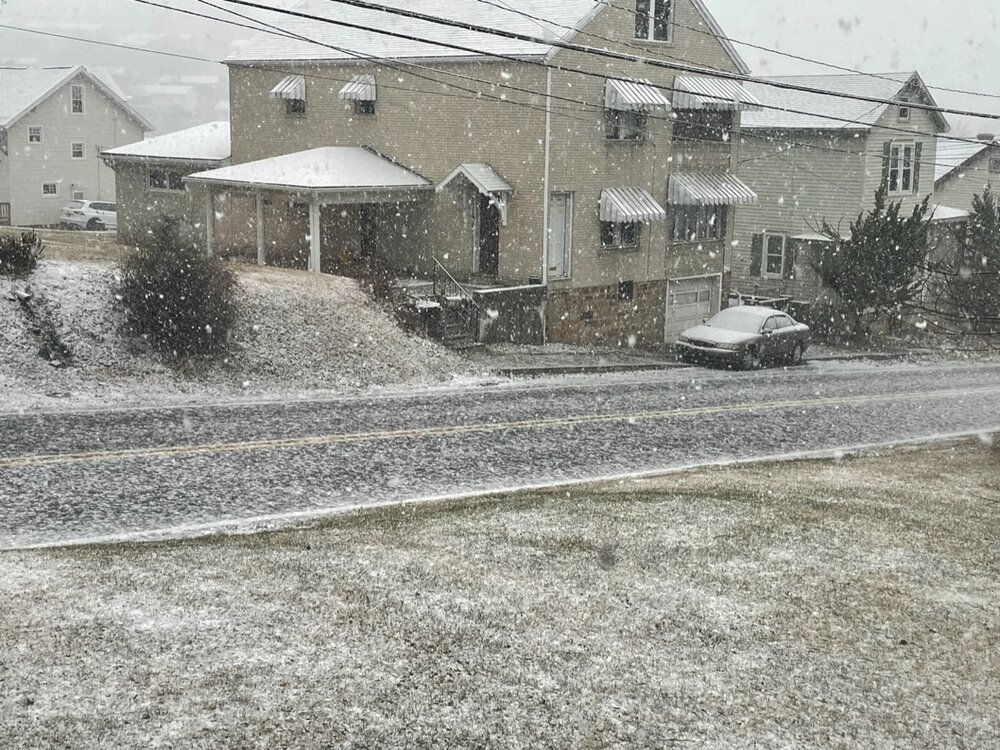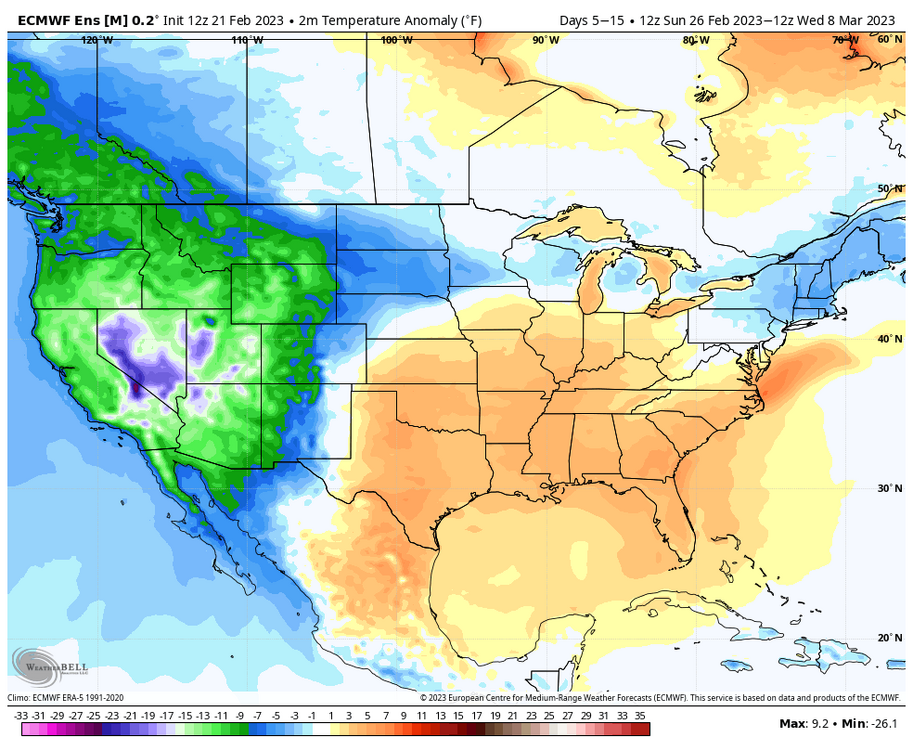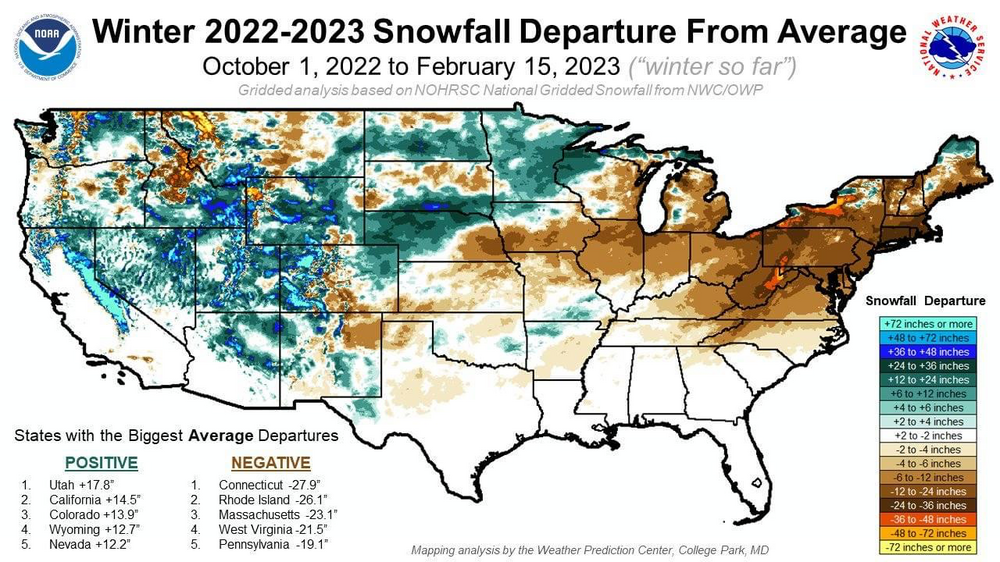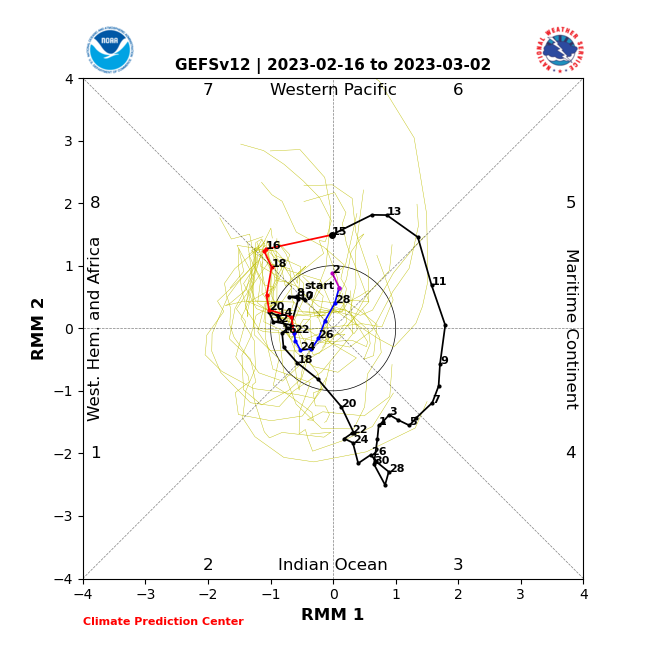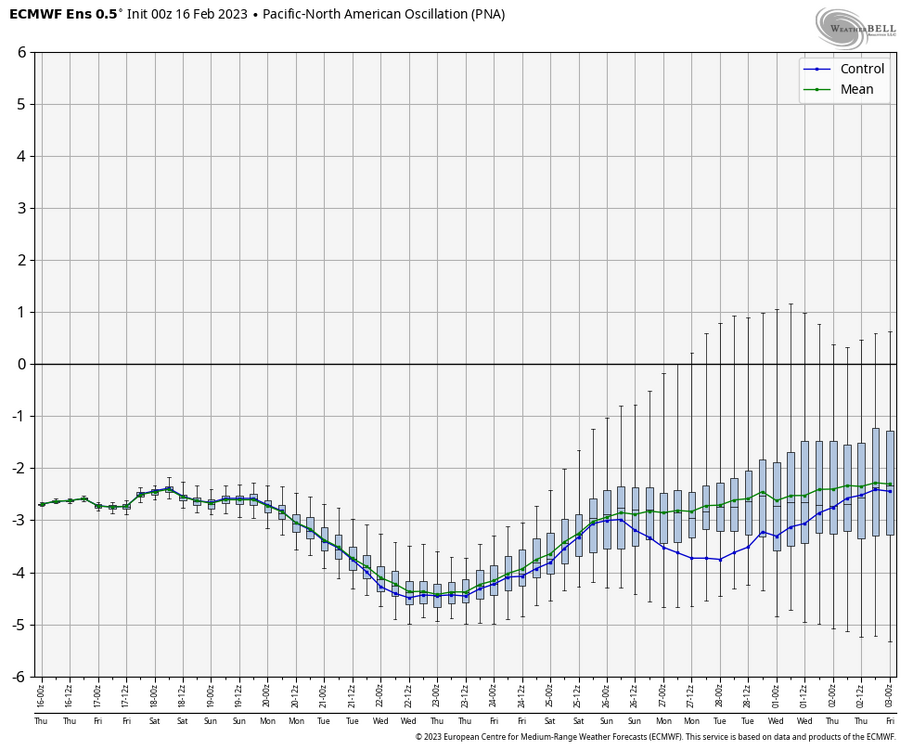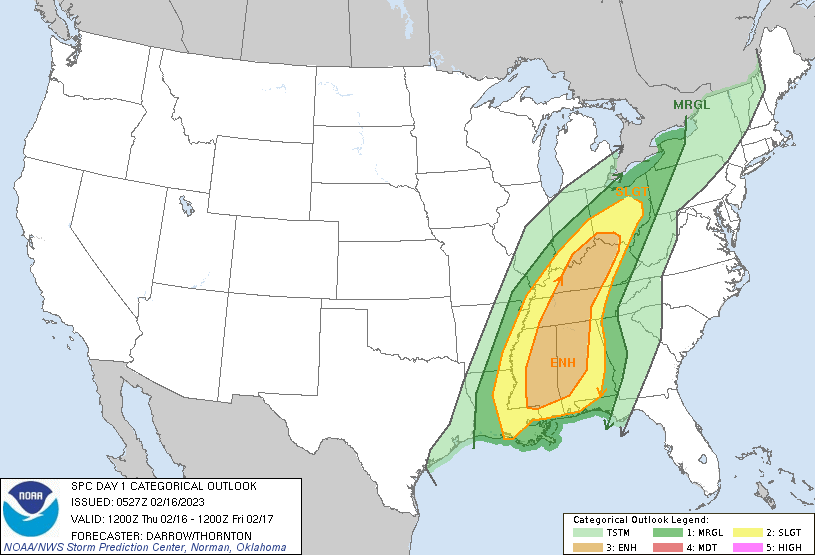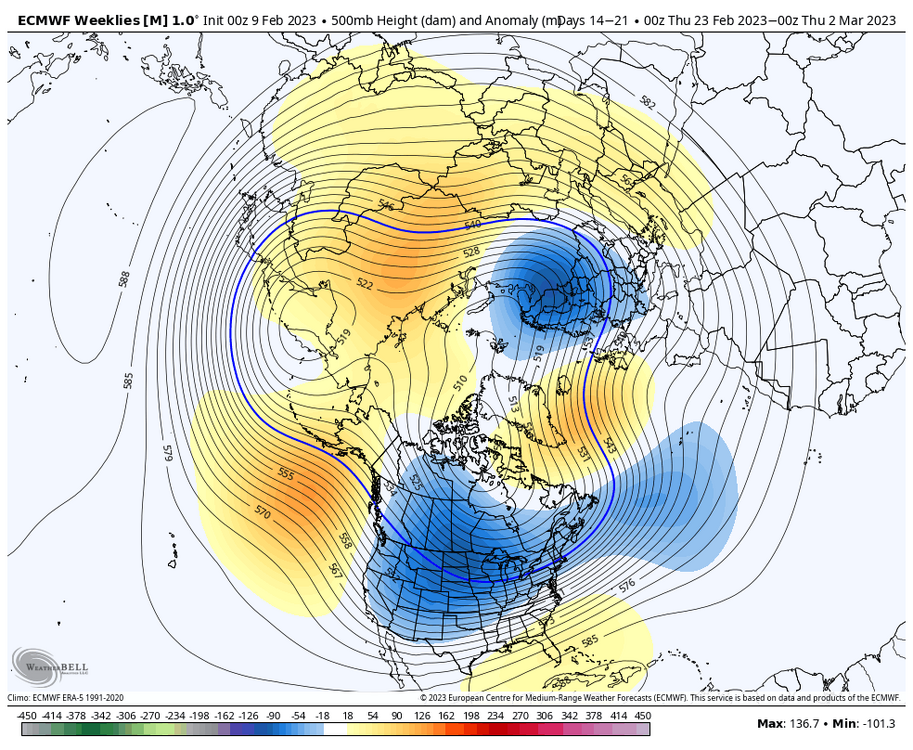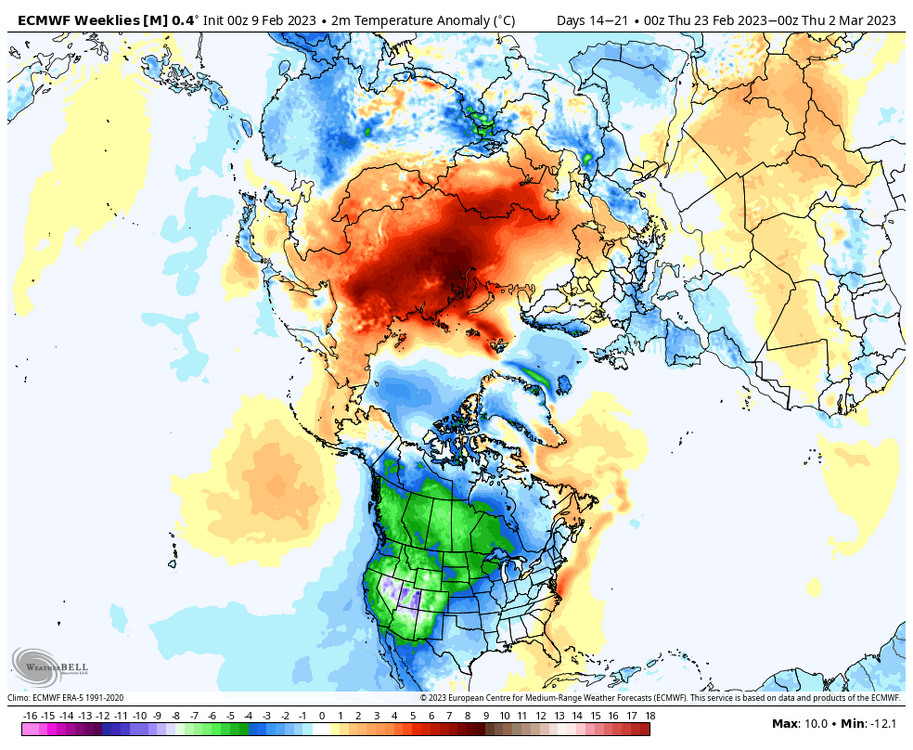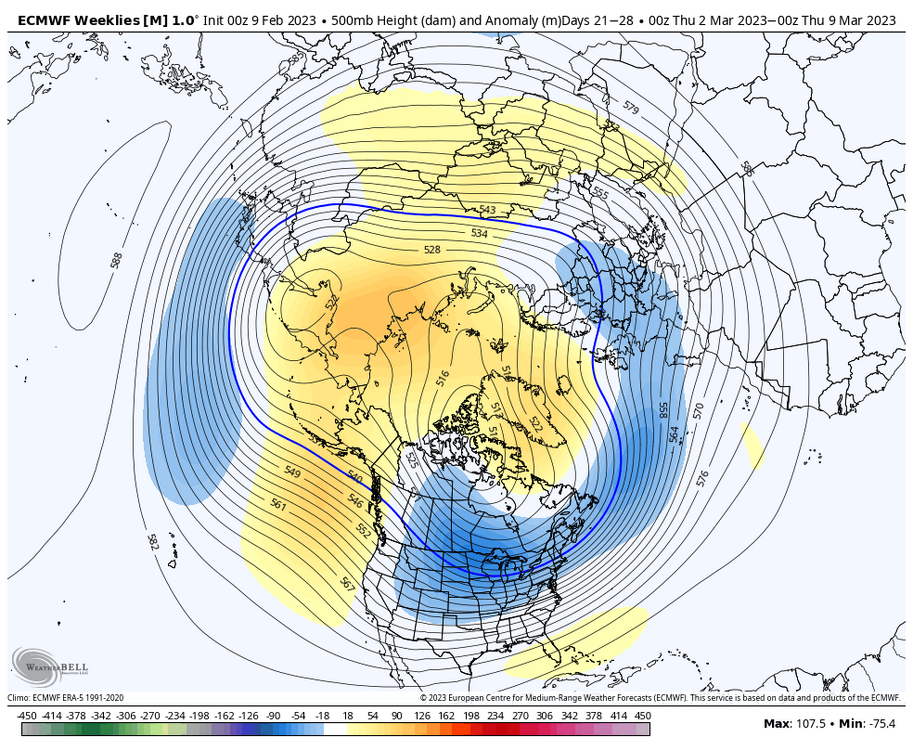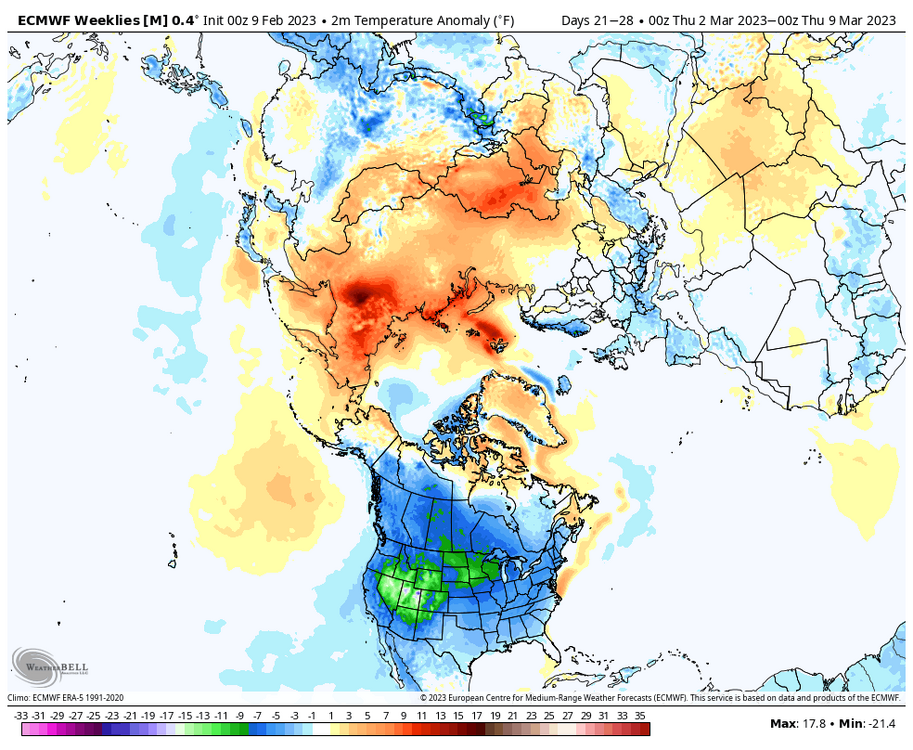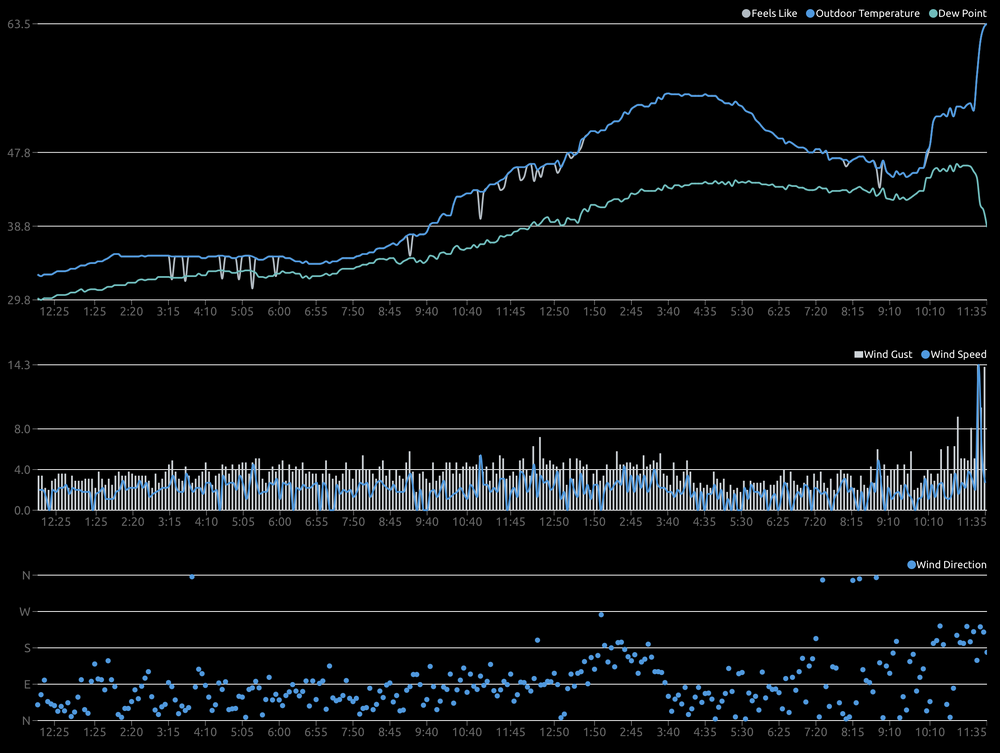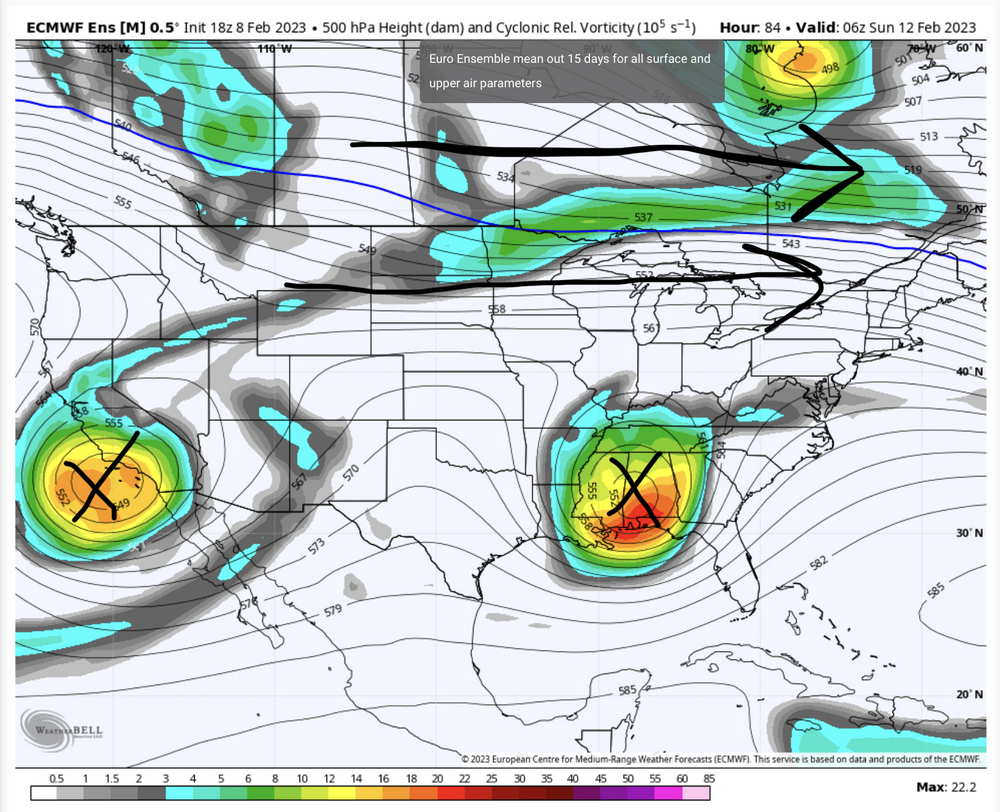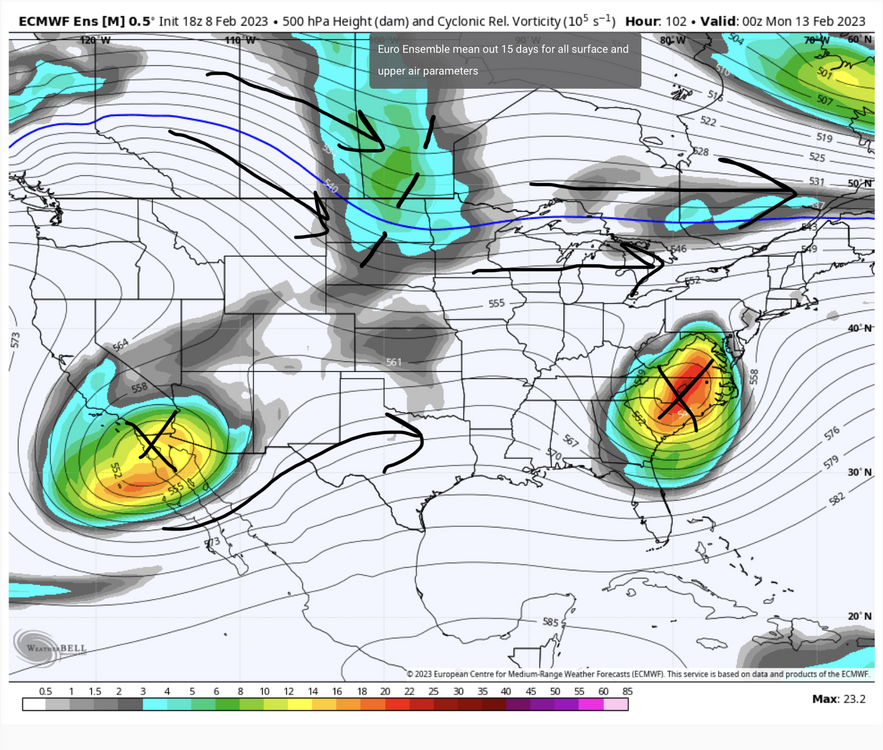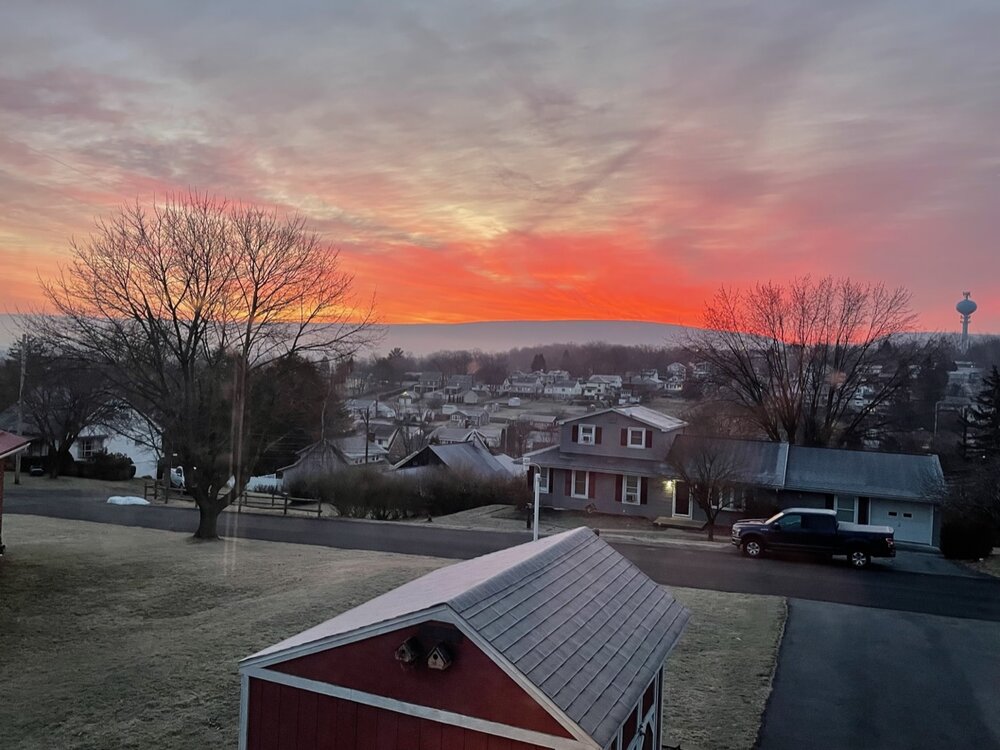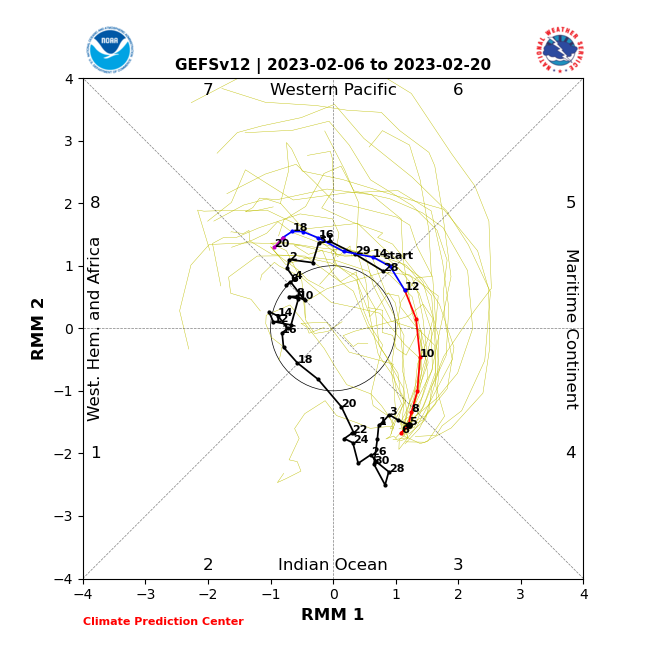
MAG5035
Meteorologist-
Posts
5,718 -
Joined
-
Last visited
Content Type
Profiles
Blogs
Forums
American Weather
Media Demo
Store
Gallery
Everything posted by MAG5035
-
Central PA Winter 2022/2023
MAG5035 replied to Blizzard of 93's topic in Upstate New York/Pennsylvania
I’ll say lol, it’s pouring snow right now. Might as well get what will prob be the only snow pic of the month in. First measurable since 1/31. Splotchy roads caved -
Central PA Winter 2022/2023
MAG5035 replied to Blizzard of 93's topic in Upstate New York/Pennsylvania
32/24ºF and moderate snow. -
Central PA Winter 2022/2023
MAG5035 replied to Blizzard of 93's topic in Upstate New York/Pennsylvania
Snow showing on the 511 cams in the US 219 and 22 corridors in the Laurel’s (Cambria co). A likely indicator the I-99 corridor (Altoona/State College) is going to have a period of snow that might accumulate a bit when the main slug of precip arrives shortly. -
Central PA Winter 2022/2023
MAG5035 replied to Blizzard of 93's topic in Upstate New York/Pennsylvania
Precip just started. Pingers and 31/23ºF -
Central PA Winter 2022/2023
MAG5035 replied to Blizzard of 93's topic in Upstate New York/Pennsylvania
#Snowtown #BaseState #NewNormal lol LOX’s discussion is pretty fun. Also mentioned in their full discussion in addition to 2-5feet of snow above 4k feet is the possibility that downtown LA goes 8 consecutive days without cracking 60ºF if the temp forecasts are correct. -
Central PA Winter 2022/2023
MAG5035 replied to Blizzard of 93's topic in Upstate New York/Pennsylvania
30/23ºF here with precip pretty close to arriving. I’m expecting more frozen (probably sleet) over ZR during the mixed phase of this event this morning. Short range guidance like the 3k NAM show a lot of freezing rain despite wet bulbing 925 and even 850mb temps below zero pretty far down into the central mountains.. so I don’t buy the widespread ice accrual outside of the ridge tops and the eastern Allegheny Front. I dunno if it’ll happen here, but I wouldn’t be surprised if a place like UNV sees a period of snowfall up front. Like I said yesterday, could be pingers mixed in with rain for a time outside of the advisory area (Sus Valley) as 925mb temps cool below zero with precip arrival but surface temps probably stay above freezing. As it looks currently, probably the Harrisburg area is the non-advised area in the LSV that has the best chance of that scenario. -
Central PA Winter 2022/2023
MAG5035 replied to Blizzard of 93's topic in Upstate New York/Pennsylvania
High gust on my station so far today has been 33mph, so nothing too crazy. Dewpoints have been nosediving this afternoon. 47/11ºF. -
Central PA Winter 2022/2023
MAG5035 replied to Blizzard of 93's topic in Upstate New York/Pennsylvania
It’s def been a weird couple days. This is occurring with all of PA having sub 540dm thickness. It’s plenty cold aloft but not at the surface/low levels being disconnected from a low level arctic air source currently. Add in the increasing solar input/daytime heating with today’s instability too to make the radar look a bit summery. With regards to the overall column up to 500mb, It was same thing yesterday without the convection. Sus Valley cracked 60 being aided by dry air/downsloping but still technically having a “snow column” in terms of 1000-500mb thickness. Literally the first winter headlines I’ve had in nearly a month haha. Looking at the HRRR, <0ºC 850mb gets routed pretty quickly after precip arrival but the 925mb (3000ft) level seems to wet bulb down a bit and it is fairly solidly below freezing in most of the Sus Valley the first couple hours after the precip onset. Could indicate a period of pingers or rain mixed with pingers even in some parts of the non advised areas of the Sus Valley. Any ZR issues I feel will mainly be confined to parts of the central and north central where there will be somewhat colder surface temps hanging in. Surface temps in the Sus Valley are generally mid-upper 30s when precip gets there. A snow supporting column will hang on for a bit after precip onset the further NE one goes in PA, especially above I-80. -
Central PA Winter 2022/2023
MAG5035 replied to Blizzard of 93's topic in Upstate New York/Pennsylvania
You definitely outdid yourself taking winter with you this year haha. This is a 10 day average for D5-15 coming up. -
Central PA Winter 2022/2023
MAG5035 replied to Blizzard of 93's topic in Upstate New York/Pennsylvania
Hurricane Hazel in 1954 for sure, still the only Cat 4 to ever impact North Carolina. It was being pulled up by an approaching frontal boundary and was moving rapidly enough that it still had hurricane force wind gusts when it crossed into southern PA. DCA and PHL had gusts to near 100mph, BAL 84mph, Harrisburg 69mph. The mid 1950s were quite a time for major east coast hurricanes. -
Central PA Winter 2022/2023
MAG5035 replied to Blizzard of 93's topic in Upstate New York/Pennsylvania
Our latest two spring fling February frolics into the 70’s in 2017 and 2018 both eventually yielded to key major winter storms in C-PA and overall favorable periods, esp in 2018. The March 12-15, 2017 storm was a NESIS 3 and 2018 had 4 NESIS ranked events in March consisting of two 2’s and two 1’s of which one was the March 22-23rd snowstorm. -
Central PA Winter 2022/2023
MAG5035 replied to Blizzard of 93's topic in Upstate New York/Pennsylvania
Figured this was appropriate to some of the general discussion, posted courtesy of NWS PIT’s Facebook a little bit ago. It is what it is, the overall winter pattern to date is evident in the placement of these departures. Lack of any cold westerly or northwesterly cyclonic flow is especially evident in the Alleghenies stretching down into WV, the LES belts in NW PA and non Buffalo extreme SW NY, and Rochester/Syracuse off of Ontario. The somewhat less crappy - departure area in interior SC PA was aided by scoring the 3-6” event that hit in Mid-November when we were in a colder than average regime. I had the biggest event of the season from that Mid-Nov event here (5.5”), and that’s pretty much what has this one ahead of what 19/20 delivered in the snow department in this area. I’m not looking for any sympathy since I’ve been one of the lucky ones in the subforum but as someone who likes to hit the slopes and one that favors snowpack retention, I’ve generally been on the same footing as everyone else (no snow on the ground) aside from a few days in November, the 7-10 days centered on X-Mas and those few days in late January. It seems like forever ago that we managed the coldest Christmas Eve on record here. Also, I could go a decade without seeing another snow-mix/rain event and it wouldn’t be long enough. This winter has definitely been warmer than 19/20.. specifically after the turn of the new year. 19/20 had some different driving factors, mainly a record strong PV and associated ++NAO/AO that wouldn’t quit. This hasn’t been quite like that in that realm with the December blocking that didn’t deliver and some other instances of PV stretching that led to some of our other brief attempts at winter weather. This winter has been mainly Pac and MJO driven in my opinion. The major SSW event that is ongoing is likely to be a big factor in eventually ensuring a different result this March as compared to that March. Big question will be can we finally capitalize and get some decent snow events. -
Central PA Winter 2022/2023
MAG5035 replied to Blizzard of 93's topic in Upstate New York/Pennsylvania
The significant cold anomalies in the SW US have been remarkably persistent most of the winter (much like the SE ridge on this side), specifically the last 30 days but on a month by month basis November averaged well below average as well. The only fairly normal month temp wise in your neck of the woods was December. Unfortunately the really negative PNA that has been firmly established as of late looks to continue unabated and that’s going to weigh heavily towards discharge of Canadian cold centering towards the western half of the CONUS regardless of whether we push some cold into C-PA eventually. Revisiting my post from last Friday: So nearly a week later now, MJO as of the 1x per day update this morning incorporating 0z data is on the border of Phase 6/7. A tad slower but it still moved and is moving rapidly through these warm phases. All the guidance does get it into 8 now in the next few days. Key thing they are showing now, is a curl back instead of further advancement into 1-2. Here’s GFS as an example: Now this is better than yesterday’s version of this forecast, as the GFS looped it right back into the P5/6 region by the beginning of March. That scenario would figure to be quite a blow to setting up any kind of wintry run during the first half of the month where you can still put together a cold pattern that can keep snow on the ground in our region. I’m still not really enthusiastic about curving back into 7 either, as the pattern for that phase still looks an awful lot like what the models have generally been suggesting… which in shorthand is available cold weighed to the west but trying to press the SE ridge… setting a storm boundary that we may or probably won’t be on the right side of. As I said in the quoted post from last week, I think we need to carry that pulse of tropical forcing at least modestly into the colder phases 1-2 as I believe that is needed to force a big shuffle of the status quo. In the meantime, here’s what we’re faced with. This is no bueno. This index has been a primary driver in this SE ridge and cold western US regime and will continue to give us trouble. I feel like the PNA gets overlooked for the EPO sometimes when talking eastern cold. That kind of magnitude -PNA is a very dominant signal to overcome with a +NAO/AO. I don’t even think the +NAO/AO would be a problem because there’s finally a lot of really cold air progged to build and be available in Canada that can press. The period the models have been occasionally showing some mixed/frozen events for us coincide with a forecast dip negative in the EPO. The cold will try to press but that SE ridge induced by the super negative PNA western trough is going to make it hard. The other factor is the stratwarm, which is definitely a thing now and occurring currently as a full blown SSW. I’ve pretty much viewed the MJO forcing as our primary factor in getting potential winter weather back sooner, perhaps before the month is out while the stratwarm was more of a long game type thing that, in lieu of the MJO not working out in the interim.. probably makes the back half of March into April cold anyways when we’re pretty much over it. The stratosphere thing is definitely interesting. If you brave the terminology and discussion in Dr. Cohen’s weekly posting, he considers this event possibly a unique example as models continue to weaken/even potentially split the strat PV after the SSW. That type of stuff would suggest eventual blocking in the NAO realm. Guess we’ll see, I’m admittedly not super knowledgeable and still learning when it comes to the stratosphere stuff. -
Central PA Winter 2022/2023
MAG5035 replied to Blizzard of 93's topic in Upstate New York/Pennsylvania
Temp here at home managed to crack 70ºF (70.2) yesterday. Here was some of the climo for yesterday per CTP. Bradford and Williamsport obliterated their daily record. Rainfall slated for today looks to come in two main parts.. a slug of rainfall that arrives around lunch time and lasts most of the afternoon and then another area associated with the frontal passage later overnight Thurs night/Fri morning. The stuff with the frontal passage may include some thunder but instability is likely to be elevated with low levels stable (cooler with the afternoon rain/clouds plus timing of FROPA later at night) in central/eastern PA. Latest HRRR that goes out that far (6z) tried to generate a little bit of CAPE in the Sus Valley right before frontal passage, likely trying to push a warm nose there. But again, I think convective elements are likely limited to potentially a few strikes/rumbles and maybe some gusty winds with the frontal passage. SPC D1 -
Central PA Winter 2022/2023
MAG5035 replied to Blizzard of 93's topic in Upstate New York/Pennsylvania
@canderson The GFS extended maintained some SE ridging (although a good bit colder overall in the east) but the latest run of the Euro weeklies that ran a couple nights ago definitely did not beyond week 2. It had the entire lower 48 cold with no SE ridging starting from about the end of week 2 the whole way through the end at D46. Week 3 (7 day anomalies) Week 4 It’ll be interesting to see what the MJO does. Most guidance gets it rapidly to Phase 8 as soon as the middle to latter part of next week. I think what happens after will be important, as maintaining convection in the 8-1-2 realm would probably go a long way to driving the wholesale change in the pattern at the mid latitudes we need to go on an actual wintry run. The MJO was persistently forecast to hit those phases in early to mid January but never actually emerged into any phase til it got to 3 late month. Theres also the stratosphere, as all guidance has been predicting significant warming and at least some stretching/displacement of the stratospheric PV and this starts occurring in the next week or so. The GFS/GEFS appears go as far as to try to split it. Either way, it’s significant enough that it will likely have an impact on the pattern down the road the next few weeks and a recent example of this is 2018. If it played out that way I think we’d be seeing snow opportunities well before Mar 23. -
Central PA Winter 2022/2023
MAG5035 replied to Blizzard of 93's topic in Upstate New York/Pennsylvania
It’s likely to be quite a + departure by the end of next week. The system following the weekend one we had been watching slated to cut next week seems poised to drive an even more prolific warm push out ahead of it, probably centering on Wed/Thurs. Probably a record or near record challenging warm shot for us. 1 day anomalies over the northeast are nuts with ensemble means of the Euro and GEFS showing +20-30ºF over our area and the rest of the northeast. Other aspect is likely a potential severe weather outbreak at least into the Deep South some of the Ohio Valley. 12z Euro manages to drive up non negligible SBCAPE’s of a couple hundred J/kg all the way up into Ontario. Not at all a common thing to be seen at our latitude and higher in mid February. Def has the look of having some thunder with the frontal passage either way. -
Central PA Winter 2022/2023
MAG5035 replied to Blizzard of 93's topic in Upstate New York/Pennsylvania
I mean I’m only describing what happens with calm winds at the surface and clear skies, radiational cooling. KABE is up to 48 now with a WSW wind blowing. There’s two other station’s in that area that are still cooler and others in the general area that have 20 degree differences between them. -
Central PA Winter 2022/2023
MAG5035 replied to Blizzard of 93's topic in Upstate New York/Pennsylvania
CTP added their climo section on with their latest update an hour ago. MDT hit 61 during the day but JST and AOO spiked up to hit 64 right before midnight. Temps are falling now back this way. The 64 at a place like JST is nuts this time of the year, though apparently it also happened in 1925. Looked like MDT spiked up to 61 again after midnight as well, just missing the 2/10 daily record of 62 set back in 1960. -
Central PA Winter 2022/2023
MAG5035 replied to Blizzard of 93's topic in Upstate New York/Pennsylvania
Judging by the calm winds in the obs I’d say that immediate part of town is decoupled and having radiational cooling at the surface since it’s currently clear in eastern PA. There’s a couple other obs (on Mesowest) in that area that are also in the 30s. It’ll spike once that wind and very wam air just aloft mixes down. Similar thing happened here earlier this evening as I posted about a bit ago. My temp had fallen to 45 during the mid evening and spiked to 64 just before midnight when the wind mixed down. -
Central PA Winter 2022/2023
MAG5035 replied to Blizzard of 93's topic in Upstate New York/Pennsylvania
Looking at the model guidance tonight, there remains some support in getting precip above the Mason-Dixon into the LSV, esp into parts of Adams/York/Lancaster. Most prolific precip maker was the RGEM, delivering a stripe of 1”+ QPF across that area in a deform band… which def seems to be an outlier. The issue I’m seeing as this threat starts getting dialed in is that even if we do get this to come up enough to deliver some precip up into southern PA, thermals may end up just a bit too warm.. or relegating any snow to the higher ridges in southern PA. That’s not necessarily because of the obvious warm air mass all around but that the storm itself matures and “stacks” all the way down in GA into the Carolinas. The dynamic processes driving the cold pool with the closed low and snow supporting column peak down there. The critical column levels in this situation (850/925 mb) modify as the matured storm tracks east below us and doesn’t track north enough either. We need this to be drawn all the way up the coast so we could not only see the precip but to get into the cold pool aloft to have a chance at seeing snow. I don’t see enough from the progged upstream northern branch feature (which i posted about yesterday) to allow this to draw up further either. The result is a more regional and elevational snow event centered on some portion of the southern/central Appalachians (def western Carolinas, eastern TN and SW VA). Most guidance gets measurable down all the way into at least the high ground of northern GA and I may be slightly amused that the 0z NAM tried to make Atlanta the “new Harrisburg” lol. I find it pretty wild that this kind of event is even on the table considering the current pattern we’re in teleconnection wise and being in the thick of a Phase 4-6 MJO run. But most/all of us are probably going to manage to be too far north to see a snow event with this anyways. -
Central PA Winter 2022/2023
MAG5035 replied to Blizzard of 93's topic in Upstate New York/Pennsylvania
The wind has finally arrived, and it has really spiked the temps. I had a high of 55ºF this afternoon and was down as low as 45ºF around 930pm or so with light winds. The wind arriving has mixed down the crazy warmth west of the Laurels and I think I might have you LSV’ers beat in the spring fling department at the moment. 63ºF at 1143pm, and it was as high as 64. Insane spike.. guess that’s good for about 40-45 degrees above average lows lol. -
Central PA Winter 2022/2023
MAG5035 replied to Blizzard of 93's topic in Upstate New York/Pennsylvania
So I hear this winter sucks lol. I’ve been playing with the NOWData lately using MDT doing some previous year comparisons of how we’re doing this winter to date (thru 2/7). They have measured 5.9” so far this season, average to date is 17.2”. Winters in the last 30 or so that are comparable (within a couple inches) or worse. 2019/2020 (5.1”), 2016/2017 (1.9”), 2007-2008 (5.3”), 2006-2007 (2.6”), 1994-1995 (6.6”), 1991-1992 (1.7”), 1988-1989 (6.9”). Several others that were bad overall winters were below average in 9-12ish range. That leaves my favorite find of this deep dive… 1992-1993, which had 6” to date. Most of that came from the Dec 92 nor’easter that turned to rain in the Sus Valley, so some of the LSV was prob in worse shape than that. I always knew that 1992-1993 was a winter heavily weighed on the two big hitters in C-PA (the Dec 10-12, 1992 nor’easter and March 93 Blizzard) but I never realized how much that winter sucked in between for a whole two months until about mid-Feb with above average temps and little snow. UNV, hit hard with 18” from the Dec storm had only 4” from when that ended Dec 12th to Feb 12 with no single snowfall greater than an inch or so. Post Feb 12th they had over 70” (28” from the 93 storm) to total about 93”. MDT ended up with over 47” for the season. That’s one heck of a turnaround. -
Central PA Winter 2022/2023
MAG5035 replied to Blizzard of 93's topic in Upstate New York/Pennsylvania
I dunno if I’d call progressive directly the problem here. Certainly the northern branch is progressive but this potential event has trended away from a tailing wave running along a frontal boundary into a closed off upper low cut off from that flow. The former scenario was one that required perfect timing and the latter scenario (what guidance has been showing as of late) is one that needs a way to get some latitude. Gonna show 3 panels from the new 18z Euro ensemble mean. Initially, there’s a shortwave in the northern branch that passes Friday Night/Sat ahead of the closed low in the south and a positively tilted trough orientation. 60hr At 84 hours, the closed low is cut off from the northern branch but progressing along with the upstream shortwave diving into California pressing. The key to getting this up high enough to catch C-PA in my opinion is getting any kind of buckling upstream in the northern branch to draw the low up even just a tad. The Euro/EPS indicate a bit of digging with a NS shortwave in the north central at 102, where the GFS/GEFS doesn’t have much. Additionally, the GFS/GEFS is a bit faster progressing the closed low. The Euro being sharper with this feature is likely a big reason why it’s the most ambitious with affecting PA. So in terms of temps…. yea overall temp pattern is warm. With that progressive northern branch jet that high in latitude thanks to a currently +AO/NAO and +EPO, it really shouldn’t be much of a mystery why. What makes this a potential snow oasis in a sea of Pacific modified air is the closed upper low itself is fairly deep and would have a cold pool aloft sufficient for a snow column with good precip rates and probably some elevation as well. If the system comes north enough, this would likely be just an enough to be a snow event in the central counties, and might be more of an elevational deal in the Sus Valley with marginal low level/surface temps. That’s a big if, because I’m still not sure we can get much precip above the mason-Dixon. Want to see more model support for that obviously, but the latest Euro and ensembles were certainly at least mildly interesting. If it doesn’t get us it’s probably going to give WV, interior VA and perhaps even the higher western Carolinas a snow event, which I guess would be hilarious if one were into schadenfreude kind of humor. I guess Elliot technically still would be on track with his 70 is more likely than snow call lol. Although, he did acknowledge this event in a post just a bit ago at 8pm. Surprised no one brought that up. -
Central PA Winter 2022/2023
MAG5035 replied to Blizzard of 93's topic in Upstate New York/Pennsylvania
-
Central PA Winter 2022/2023
MAG5035 replied to Blizzard of 93's topic in Upstate New York/Pennsylvania
I said this back on January 15th, a long journey back to page 120 in this thread haha. As it was, despite a wholly above average January, we did have a couple chances late month and the Jan 25th event. Only fitting of this winter that Millersville was a 1/10” stick slant away from keeping the 2/4/95 record in tact at that point, by the way. And then actual colder than normal took until last week to arrive, culminating in the brief but insane charge of arctic air into New England. The bolded portion was the big thing though. At the time, models didn’t loiter the MJO in phase 3 for 10+ days so it pushed the timeframe back some but while they were taking it back in the null phase you could see at that range a sustained/stronger MJO pulse could continue to progress into the 4-6 range. It also wasn’t much of a consensus til recently either (Euro continued to avoid the warm phases) but it seems like the NCEP guidance ended up being better with that particular forecast...being persistent in sustaining the MJO progression into warmer phases. Here’s what it looks like today: It’s brutal timing wise, right at the heart of our best snowstorm climo. And especially in a Nina but even non-Nina winters these phases correlate so strongly to eastern warmth. Somewhat good thing is that this and other guidance keep it moving and don’t stall it in any phase, eventually setting up for a run through the more favorable side…theoretically. I think after about the next 7-10 days we may have an idea of a direction we may take getting into late February and early March. My first thoughts are that there’s a decent chance that March may try to make some noise, perhaps even as early as late this month if we can quickly get out of these warm phases and try to reshuffle the pattern accordingly. That’s something we’re not going to decipher out of the D10-15 range of the op models today though with any certainty. So we’ll see…We’re having a remarkable stretch of this persistent southeast ridging, it’s gotta break down at some point. And March being a transition month seasonally (wavelength shortening) is a good time for that to happen.

